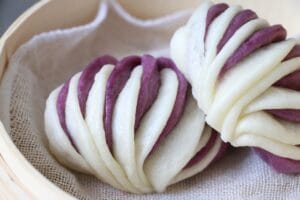蜂蜜干粉系列产品的应用
Applications of Honey Powder Products
Bread and Cakes
Effectively improves product texture and imparts a superior mouthfeel; enhances and enriches product aroma, promoting the development of an appealing color; helps keep products moist and soft. Furthermore, it can also promote dough fermentation, inhibit or mask undesirable notes such as off-flavors from raw materials or greasiness in the finished product, aid in easy mold release, and contribute to extending the overall shelf life of products, among other benefits.
Frozen Dough
Honey powder plays a crucial role as an improver in frozen dough technology by protecting yeast and reducing ice crystal formation. It significantly enhances the stability of dough throughout the freezing, storage, and thawing processes, as well as the quality of the final baked product.
Meat Products
In meat product processing, honey powder is suitable for applications such as prepared meats, various types of sausages, and barbecue products. It imparts and stabilizes product color, enhances the meat's inherent aroma, harmonizes the flavors of various spices and seasonings, while also effectively inhibiting and masking undesirable flavors, thereby comprehensively optimizing the product's sensory qualities.
Biscuit/Cookie Products
It significantly optimizes the texture, flavor, appearance, and shelf life of biscuits/cookies, leading to an overall enhancement of their quality. In the production of mooncakes (such as Cantonese-style and Suzhou-style, for both crusts and fillings), honey powder acts as a functional natural ingredient, capable of positively enhancing product quality in numerous aspects.
Seasoning Products
In various types of seasonings, the addition of honey powder helps to better reveal the natural aromas of different ingredients, leading to a more harmonious and pure overall flavor profile. At the same time, it aids in reinforcing and accentuating the seasoning's predetermined primary flavor profile, ensuring a more distinct and focused taste experience.
Ice Cream and Dairy Products
When used in ice cream products, it skillfully optimizes and blends the overall flavor profile, allowing the milky base and primary aromas to be expressed more authentically, with enhanced roundness and naturalness. At the same time, it significantly improves the smooth and delicate texture of the ice cream, imparting a silky, rich, and delightfully melt-in-your-mouth eating experience.
蜂蜜干粉在多种食品行业的应用
Bread Product Applications
(1) Optimization of Dough Properties and Workability: * Effectively softens the gluten structure, significantly enhancing dough elasticity and extensibility. * Improves dough handling feel and sheen, enhancing the overall operational experience. * Helps increase product specific volume, making the finished bread appear fuller.
(2) Anti-staling and Freshness Retention: * By retarding starch retrogradation and reducing the rate of recrystallization, it effectively slows down bread staling, extending product softness and shelf life.
(3) Texture and Mouthfeel Improvement: * Promotes good dough fermentation, resulting in a finer and more uniform internal crumb structure in bread. * The finished product offers an improved mouthfeel, is non-sticky to teeth, and possesses excellent palatability.
(4) Flavor Modification and Enhancement: * Skillfully balances and corrects the product’s primary flavor profile. * Its unique flavor-masking and modifying properties can effectively cover or harmonize undesirable odors or off-notes that may arise from other auxiliary ingredients (like certain functional additives). * Even towards the middle and later stages of its shelf life, it helps the product maintain its pure, natural, and authentic flavor. * This unique improvement makes it an ideal choice for enhancing product flavor stability, particularly for medium to long shelf-life products with demanding flavor standards.
(5) Moisture Retention and Yield Improvement: * Possesses excellent water-holding and water-locking capabilities, significantly enhancing the dough’s water retention rate. * Contributes to a higher final yield of baked products.
(6) Shelf Life Extension: * By effectively reducing the product’s water activity, it can significantly extend the product’s shelf life, depending on the dosage level.
Suggested Dosage:
The addition level should be flexibly determined based on the manufacturer’s specific product requirements, desired improvement goals, and the existing formulation system. Generally, a recommended dosage is 1.0% to 6.0% based on the total flour weight. It is advisable to determine the optimal amount incrementally through small-scale trials.
Biscuit Product Applications
(1) Maintaining Crispness and Preventing Softening: * * Effectively reduces the final water activity (aw) of biscuits, which is crucial for maintaining their ideal crisp or crunchy texture. * * Significantly enhances the biscuits’ resistance to moisture absorption, effectively preventing them from becoming damp and losing crispness during storage and shelf life.
(2) Flavor Optimization and Lasting Freshness: * * Modifies and enhances the overall flavor of biscuits, masking or balancing undesirable odors (off-notes) that may arise from other formula ingredients. * * Helps maintain the pure and natural flavor of the product and effectively extends the biscuits’ optimal eating quality period.
(3) Promotion of Ideal Color: * * During baking, it helps promote Maillard and caramelization reactions, enabling the biscuit surface to develop a uniform, appealing golden-yellow or light reddish hue.
(4) Improved Shaping and Appearance: * * Positively influences dough extensibility and plasticity, helping biscuits achieve sharper imprinted patterns and more defined edges. * * Enhances the product’s overall visual appeal (“sell-ability”), making it more commercially attractive.
Suggested Dosage: The recommended dosage is typically 1.0% to 1.3% based on flour weight. The specific dosage should be adjusted and optimized through actual baking trials based on product formulation, biscuit type, and desired targets for crispness, color, and flavor.
Applications in Various Cake Products
(1) Optimization of Structure and Product Form: * Effectively improves the internal structure of cakes, enhancing batter stability and structural support. * * Results in a fuller, more upright finished cake, ensuring stable product form and effectively preventing issues like shrinkage or collapse during cooling or storage.
(2) Enhancement of Flavor Complexity and Mouthfeel Improvement: * Naturally balances and enhances the overall flavor of the cake, rendering its sweetness milder and its aroma richer. * * Effectively masks or transforms potential off-notes from certain ingredients (such as an “eggy” smell from eggs) and reduces product greasiness. * * Imparts a pure, natural, and refreshingly sweet aftertaste to the cake, enhancing the overall flavor experience.
(3) Moisturization, Water Retention, and Shelf Life Extension: * Leveraging its excellent moisturizing and water-locking properties, it helps maintain the cake’s moistness and soft texture for an extended period. * By effectively reducing the finished product’s water activity (aw), it supports the extension of the product’s quality retention period and overall shelf life.
(4) Promotion of Ideal Color and Flavor Synergy: * Helps cakes develop a uniform, appealing golden-yellow or caramel color during baking. * * It can create good synergistic effects with other flavoring ingredients (such as vanilla, cocoa, fruits, etc.), making the cake’s overall aroma and flavor more harmonious and complex.
Suggested Dosage: The recommended dosage is between 0.8% and 1.2% of the total cake formula weight (calculated on a batter basis). The specific dosage can be adjusted through trials based on product type, desired flavor intensity, and textural improvement goals to achieve optimal results.
Applications in Certain Beverages
The application of honey powder significantly enhances the flavor complexity and authenticity of various liquid milk and cold beverage products. In products featuring pure milk, peanut, or malt flavors, it effectively mellows and enriches their original aromas; for chocolate, taro, nut, and multigrain products, honey powder imparts a more natural, full-bodied characteristic flavor, delivering an excellent mouthfeel experience.
Furthermore, in cold beverage/frozen treat applications, honey powder exhibits excellent physical modifying properties: it promotes rapid surface drying of the product and effectively inhibits ice crystal formation, thereby imparting a finer texture and a chewier mouthfeel to the product, while also significantly enhancing its melt resistance.
Suggested Dosage: 0.2% to 1.0%, or adjust as needed based on specific requirements.

Meat Product Applications
When applied to meat products, honey powder offers multifaceted benefits including nutritional value, safety, hygiene, and ease of use, significantly enhancing product quality. It not only improves meat tenderness and chewiness but also aids in developing and retaining product color, contributing to a natural and appealing appearance. In terms of flavor, it effectively harmonizes various spices and seasonings, lending the product a full-bodied, natural, and lasting flavor profile, while skillfully masking potential off-notes and reducing greasiness. Additionally, its excellent water retention and moisturizing properties contribute to extending product shelf life, and its ease of use thoroughly meets the demands of industrial-scale meat product manufacturing.
Suggested Dosage: 2.0% to 3.0% of the total meat weight. Its comprehensive benefits usually become gradually apparent approximately 15 days after the product is finished.

Frozen Dough Product Applications
(1) Optimization of Dough Rheological Properties and Freeze-Thaw Stability: Effectively improves the rheological properties of frozen dough, enhancing its strength during processing, as well as the elasticity and extensibility of the dough after thawing. Through the interaction of its special components with gluten proteins, it helps protect the integrity of the gluten network structure, significantly reducing damage to proteins caused by ice crystal formation, growth, and recrystallization during rapid freezing and subsequent freeze-thaw cycles, thereby effectively maintaining dough quality and vitality.
(2) Enhancement of Thaw Stability and Finished Product Mouthfeel: Honey powder enhances the structural strength of frozen dough, helping to inhibit dough structure deterioration and stickiness caused by water migration (osmosis and diffusion) during slow thawing. This ensures the dough remains stable after thawing and is easy to handle in subsequent operations, thereby imparting superior mouthfeel, texture, and volume to the final baked product.
(3) Strengthening the Gluten Network and Promoting Yeast Vitality and Flavor: Honey powder can form more stable bound water with the moisture in the dough (this bond is typically highly stable and not easily reversible) and is evenly distributed within the gluten protein network, acting as physical support and a uniform filler. This structure not only provides yeast with better survival space and a protective barrier in harsh freezing environments but also offers an easily utilizable rich nutrient source for yeast after thawing and recovery. This ultimately helps enhance the dough’s fermentation potential and stability, imparting a richer fermentation flavor to the finished product and making it more delicious.
Suggested Dosage: The generally recommended dosage is 3.0% to 6.0% based on flour weight. For specific products, if aiming to highlight characteristic flavors or achieve more significant overall improvements, the maximum dosage can be trialed up to 10%. Note: It is recommended that all dosages be optimized through application trials under actual production conditions to achieve the desired product characteristics.
蜂蜜干粉应用的示例配方及相关参考文档
Reference Documents for Example Formulations and Related Applications of Honey Powder
PDF格式,需要Adobe Acrobat软件打开。
01
Dough rheology and bread quality
Effect of honey powder on dough rheology and bread quality

Effect of honey powder on dough rheology and bread quality
The effects of honey powder on dough rheology and bread quality were studied using sugar as controls.
02
The quality and flavor of Chinese steamed buns
Effect of dried honey powder on the quality and flavor of Chinese steamed buns premicrofermented with Pediococcus pentosaceus

Chinese steamed buns
The results showed that the total water area of the CSB increased, hardness and chewiness decreased, the specific volume (SV) increased and the pH decreased.
03
Dried Honey Products
A wide range of dried honey products.

Dried Honey Products
Dried honey products available commercially for industrial use are derived from pure liquid honey (1) to which have been added processing aids and other ingredients, (2) which has been dried to a low moisture content, and (3) which in most cases has been converted to a free-flowing product.
04
基础科学研究
蜂蜜干粉对面包面团热机械学、烘焙及老化特性的影响。

对面包面团热机械学、烘焙及老化特性的影响
来自江南大学食品科学与技术国家重点实验室:蜂蜜干粉对面包面团热机械学、烘焙及老化特性的影响。
05
对面粉指标品质影响
将部分白砂糖替换为蜂蜜干粉进行实验,研究蜂蜜干粉在蒸煮面食中的应用效果。

对面粉指标及烘焙品质的影响
探讨蜂蜜干粉在烘焙产品中的实际应用效果,从其对面粉指标的影响、对操作过程以及成品效果的作用进行全面评估,进一步验证蜂蜜干粉的功效以及特点分析。
06
与改良剂的对比
短货架期白吐司仅使用改良剂和仅使用蜂蜜干粉的的对比试验配方和过程。

蜂蜜干粉与改良剂对比
增加面团吸水率及体积,促使面团发酵,不易酸败,提高出品率;改善组织,着色容易;抗老化、延缓淀粉回生,降低重结晶速率,降低水分活度,延长货架期等。
